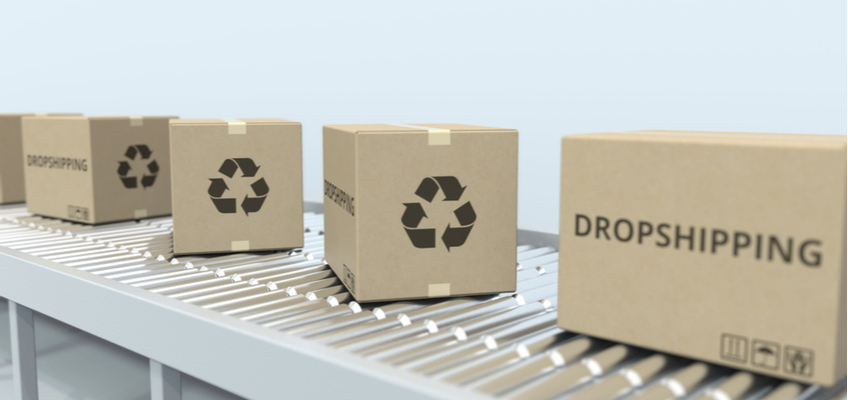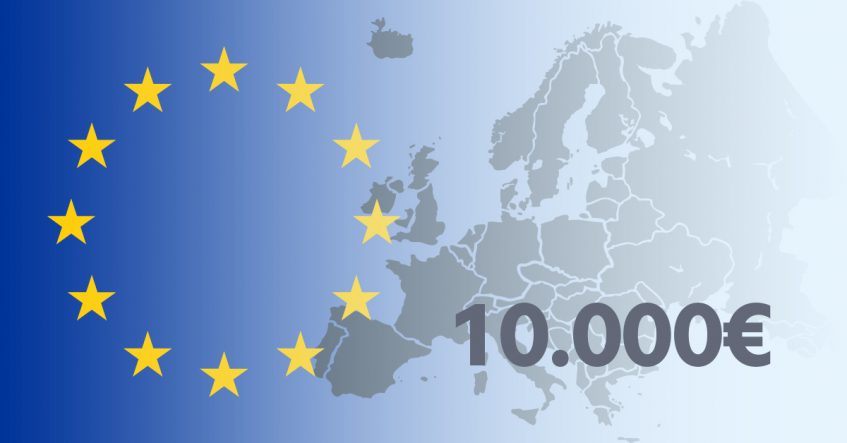
VAT on Dropshipping in 2021: Rules in the EU and the UK
Editor’s Note: This is a guest post written by Maximilian Gampl, Content Marketing Manager at hellotax.
Dropshipping has experienced a huge growth in recent years. However, the announced VAT changes for 2021 made many dropshippers doubt whether it makes sense to continue with this business model or not. In this article, we take a closer look on dropshipping, what the pros and cons are and what the impact of new VAT regulations will be. Will dropshipping still be worth it?


What is Dropshipping?
Dropshipping makes online selling and setting up an online business quite easy. It is a business model that is based on outsourcing most steps that are usually required in the production and fulfilment chain. Dropshippers sell products but do not own the stock at any time, they don’t produce the goods, don’t store inventory and also shipping is not something you they have to take care of.
Whenever you receive an order, it gets forwarded to your supplier (wholesalers/manufacturers) and they will send it to your customers on your behalf. Some dropshipping partners offer solutions for automatically sending incoming orders to them and they start with the production or with contacting the producer. Having to forward these orders manually is also still quite common.
Usually, your dropshipping partners takes care of production, storage, labelling, invoices in the package and the shipping. Most sellers do dropshipping via their own website or on online marketplaces like Amazon. Especially dropshipping on Amazon has increased steadily.
Advantages & Disadvantages of Dropshipping
Now let’s talk about the advantages and disadvantages of dropshipping to get a better idea of the whole concept and to better understand the impact of the upcoming changes.
ADVANTAGES
Low Startup Costs
As dropshipping allows you to fulfil orders without having to store the goods, you do not need to stock a warehouse. That means no costs for producing a certain number of items and no costs for the actual storage. Especially inventory costs can rise rather quicker, above all when the demand is not high enough.
Low Risk
One of the biggest advantages when it comes to dropshipping is for sure the comparatively low risk. All cost-intensive processes are outsourced and as already mentioned, there are no costs for production, storage, packaging or shipping. This makes also trying new products or in general switching the offered products rather easy.
Less Work
If you are selling goods with dropshipping, of course you have less work to do as someone who is also involved in production, storage and/or fulfilment. For this reason, dropshipping can be a great addition to eCommerce businesses, but it is also the perfect solution for start-ups. With dropshipping, you can scale easily and that is what it makes so profitable for small businesses in the early stages and for bigger ones who can use dropshipping for selling something that is outside their usual range.


DISADVANTAGES
Low Margin
As dropshippers are involved in fewer processes, there are naturally fewer steps to create value. So, the profit you make is simply the difference between the price in your shop and the price you pay to your supplier (including shipping fees, storage fees, etc.).
Less Control
Not having an own product, not producing it yourself and less possibilities in terms of packaging and individualization makes not only brand-building quite difficult, but you also need to be aware that you have less control on the processes in general. You have less control and need to rely on your supplier – also in questions of quality and reliability.
High Competition
Especially because it is so easy to start and because the costs and risks are almost non-existent, more and more traders are naturally trying it. The VAT changes this year (more about that later) could reshape the dropshipping landscape to some extend but currently the competition is really strong. This makes selling successfully with dropshipping of course a bit more challenging.
| Advantages | Disadvantages |
|
|
Which VAT Duties Have to be Considered?
For dropshipping businesses it is essential to determine where the place of supply of the goods is. This is where VAT has to be charged (if the VAT system applies).
When shipping from outside the EU (e.g. China) into the EU (e.g. Germany), the place of supply is China – so no VAT that has to be paid in China as there is no VAT.
In this case, the importer of record (usually the customer) has to pay import VAT in the country of import instead of paying taxes in China. Import VAT and duties must be paid at the rate of the EU country of import.
Importer of Record: An importer of record is a person or entity that has the legal responsibility to ensure that any good being imported complies with the legal requirements established by local and federal authorities. Source: myaccountingcourse.com


When to Register for VAT?
Usually, you have to get a VAT identification number when you are storing goods in an EU member state or when you reach a certain annual turnover (VAT threshold) in a country with distance selling.
In Germany for example, this threshold is 100.000€. So, when selling goods to Germany worth more than 100.000€ within one year, you need to register for VAT in Germany and take care of your tax tasks there, like filing VAT returns.
Currently, imported items from third countries below a value of 10-22€ (depending on the member state) are not subject to VAT at all and therefore, no import VAT has to be charged as well.
So much about the current regulations. As of 01.07.21, this system will change fundamentally.
New VAT Changes for Dropshippers in 2021
With a few changes having started on 1. January, the most interesting date this year in this matter will be 1st July 2021. With the beginning of July there will be uniform VAT threshold for distance selling, the One-Stop-Shop (OSS) will be introduced, tax exemption for products from third countries will be abolished (!) and all imports into the EU have to be declared to the customs. So, there are some profound changes coming to B2C e-commerce this year.
No tax exemption for small value items (since 1. January 2021)
Currently, there is an import VAT exemption for goods from third countries with a value of 22 euros or less. For imports below this value, no VAT is due. This exemption was abolished on 1st January in order to end a competitive disadvantage for EU companies as this VAT exempt was heavily used by online sellers to avoid paying VAT.
Sellers will have to pay VAT on all import below 150€ at the point of sale (POS) instead.
Electronic Pre-declarations for all Imports into the EU (as of 1. July 2021)
As of 1st July 2021, all goods will require a customs declaration when entering the European Union. The import VAT has not to be paid until a value of 150€ at the point of sales but declaring the import as on arrival in the EU is mandatory.
One EU-wide VAT Threshold for Distance Selling (as of 1. July 2021)
Currently, each and every member state in the EU has its own VAT threshold for distance selling, so its own turnover limit which leads, once reached, to VAT duties in the country of import. These VAT duties are for exampling getting a VAT number, filing VAT returns or do reports and tax payment to local tax authorities.


With the beginning of July, there will be one VAT threshold for the whole of Europe. This threshold will be 10.000€ and once reached, you will have to register for VAT in the country of import. If the value of your items is below 150€, you need to submit your VAT declaration using the Import One-Stop-Shop (IOSS).
Like the MOSS, the IOSS is used for the simple accounting of VAT income. However, the use of the IOSS is voluntary.
Introduction of the OSS (as of 1. July 2021)
Since online traders will have to register in more and more countries due to the lower and, above all, Europe-wide delivery threshold, the OSS procedure has been adapted to make it easier to handle the tax and to avoid to many VAT obligations for online sellers, especially for smaller ones.
With the new One-Stop-Shop (OSS), online sellers no longer have to register in several EU countries but can handle the VAT due in all countries from one point of contact. Under the OSS, suppliers can choose to register once in the Member State where they have been identified and submit a single, simplified OSS return for all their sales (distance selling) within the EU.
Special Case United Kingdom
Since the UK has left the European Union, there are a few aspects you need to consider when talking about dropshipping. Due to the Brexit, the UK is now treated as a third country and trade with EU member states becomes a bit more complicated. Even though the above-mentioned changes also affect the UK, of course, there are a few more things to keep in mind that were introduced by the beginning of the year. Some of these changes are simply a result of Brexit, other measures were decided before the UK wanted to leave the EU and are being implemented despite Brexit. But one thing at a time.
The four biggest changes as of 1st January 2021 are the following:
The Postponed Import VAT Scheme
The postponed import VAT scheme means that you no longer have to pay money up front when importing goods into the UK, but you have to declare the import VAT on your UK VAT return instead.
Exports from UK do not Affect VAT Thresholds
Sales (B2C) from UK to the EU made between 1st January 2021 and 30th June 2021 by UK ecommerce businesses will no longer be relevant for reaching the threshold limit of the country of import. These sales are now regarded as exports from the UK which are zero rated. The other way round, when selling from the EU to the UK, you will need to register for VAT.
Abolition of the £15 Low-Value Consignment Relief (LVCR)
LVCR currently means that goods with a value of £15 or less are not subject to UK import VAT. The abolition of LVCR means that for goods sold for £135 or less, VAT has to be declared and paid to the HMRC.
End of EC Sales List for UK businesses
Since the beginning of the year, UK businesses do not have to submit EC sales lists anymore.
Summary
There is a lot going on this year in the eCommerce sector. The VAT-related changes will have a big impact as for example a huge amount of dropshippers will have to pay import VAT for the first time. Especially the comparatively low margins will make a proper calculation even more important and some sellers might to say goodbye to some products in their shop as the margin is simply not high enough anymore.
Getting rid of the country-specific VAT thresholds and having a rather low EU-wide VAT registration threshold may sound rather bad at first glance. But: With the OSS, it will become quite easy to handle VAT in various countries at once – above all because VAT for several countries can be managed from one country.
In the legal and tax field, you often face penalties and other problems if you do not comply, so it is of course always advisable to get in touch with a tax advisor to stay on the safe side.
We’ll discuss more about VAT compliance and cross-border payment solutions for eCommerce sellers in a live webinar happening on February 17, at 1PM GMT. Register now and make sure you join us live to get answers to your questions in our Q&A session.






